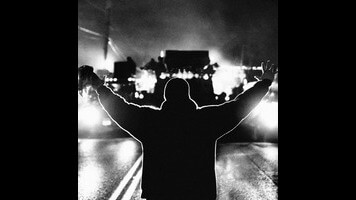It was just three years ago—on August 9, 2014—that Ferguson, Missouri police officer Darren Wilson shot and killed the unarmed Michael Brown, setting off widespread protests in suburban St. Louis and around the country. There are differing accounts of what happened that day and the reasons behind it, but to Ferguson’s residents, the shooting exemplified the overzealousness of cops in a predominately black community. As video of their demonstrations spread across social media and cable news, the images of law enforcement in riot gear intimidating people in their own neighborhoods reinforced the message the protestors were trying to deliver. The incident and its aftermath were terrifying—and galvanizing.
Sabaah Folayan’s documentary Whose Streets? focuses more on what was awakened in Ferguson than on the despair that so many felt back then—both in Missouri and among those watching around the world. Proceeding roughly chronologically from the day of the shooting, Folayan and her co-director, Damon Davis, use home video, news footage, and their own original reporting to track the growth of a grassroots protest movement, day by day. The film jumps ahead occasionally for interviews with some of the men and women who were active in organizing public action, revealing what their private lives have been like since they took to the streets.
The purpose of Whose Streets? is plain. In the mainstream media coverage of the Ferguson protests, the citizenry was largely framed as an indistinguishable, raging mob. But the story was very different on Twitter, Instagram, and Facebook, where individuals of varying backgrounds—but with shared experiences of living in and around Ferguson—gave their own personal perspective on what was happening. Folayan and Davis and the rest of their filmmaking crew are simpatico with the activists, whom they take pains to paint as people with families, vocations, and carefully considered opinions. One of the most dogged criticisms of the Black Lives Matter movement is that its anger is unfocused and devoid of long-term goals. But Whose Streets? has a very different take, showing the thoughtful planning behind some of the Missouri-based wing of the movement’s more attention-grabbing moments.
What this film is not, in any way, is comprehensive. Very intentionally, Folayan and company don’t concern themselves with the bigger picture. This is ground-level journalism, unconcerned with gathering the opinions of police or politicians, or even in talking to wings of BLM that have proliferated across the nation. The movie lets the antiauthoritarian opinions of its subjects go unchallenged, whether they’re excoriating the media or chiding President Obama for saying that he preferred to keep the matter local. There are nuances aplenty that go unexplored—again, by design.
But without over-explaining anything, Whose Streets? scores some tough points against the institutions its subjects consider to be the opposition. Broadcast news in particular doesn’t come off well, as the doc’s editors show how CNN and the major networks arrived late to the story and initially emphasized violence and destruction of property, rather than the police’s disproportionate response to lawful civil disobedience. (“What was supposed to be a peaceful vigil turned into this,” a field reporter gravely intones, over images of smashed windows.)
But the film saves its real ire for the police, who in scene after scene are shown presuming the worst of people they’re sworn to protect. As the title of Whose Streets? implies, what was really at the root of the Ferguson protests wasn’t just the death of Michael Brown, but the frustrations of ordinary Americans who keep getting treated as inconvenient interlopers in the place where they live. It’s their story that this movie tells—and persuasively.



















![Rob Reiner's son booked for murder amid homicide investigation [Updated]](https://img.pastemagazine.com/wp-content/avuploads/2025/12/15131025/MixCollage-15-Dec-2025-01-10-PM-9121.jpg)





















